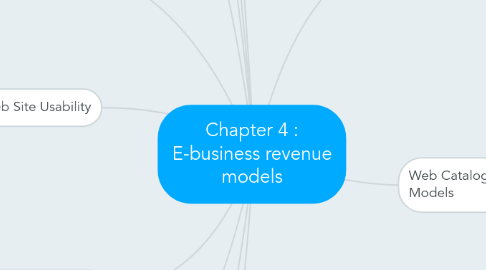Chapter 4 : E-business revenue models
por nusrah othman


1. Digital Content Subscription Revenue Models
1.1. Firms owning written information or rights
1.2. Sell subscriptions for access to information they own
1.3. Example : LexisNexis offers variety of information services
2. Advertising-Supported Revenue Models
2.1. Provides free programming and advertising messages
2.2. measuring and charging site visitor views
2.3. obtain large advertiser interest
2.4. Example : HowStuffWorks
2.5. web portals (portal) : Site used as a launching point to enter the Web
2.6. Newspaper and magazine publishers : Sell advertising to cover Web site costs
2.7. Targeted classified advertising sites
3. Advertising-Subscription Mixed Revenue Models
3.1. Subscribers pay fee and accept advertising
3.2. Web sites offer different degrees of success
3.3. Consumers Union (ConsumerReports.org)
3.3.1. Purely a subscription-supported site
3.3.2. Free information
4. Fee-for-Transaction Revenue Models
4.1. Service fee charged-based on transaction number or size
4.2. Web site offers visitor transaction information
4.3. Value chain
4.3.1. Disintermediation
4.3.2. Reintermediation
4.4. Travel agency revenue model: receive fee for facilitating a transaction
4.5. Insurance brokers
4.6. Online banking and financial services
5. Fee-for-Service Revenue Models
5.1. Companies offer Web service
5.2. Online games
5.3. Professional services
6. Free for Many, Fee for a Few
6.1. Economics of manufacturing
6.2. Leads to a different revenue model
7. Revenue Models in Transition
7.1. subscription to advertising-supported model
7.2. advertising-supported to advertising-subscription mixed model
7.3. advertising-supported to subscription model
7.4. multiple changes to revenue models
8. Revenue Strategy Issues
8.1. Channel conflict and cannibalization
8.2. strategic Alliances
8.3. Luxury goods strategies
8.4. overstock sales strategies
9. Creating an Effective Web Presence
9.1. Organization’s presence
9.2. Effective Web presence
9.3. Identifying Web Presence Goals
9.3.1. Attracting Web site visitors
9.3.2. Keeping visitors to stay and explore
9.3.3. Convincing visitors to follow site’s links to obtain information
9.3.4. Making Web presence consistent with brand image
10. Web Site Usability
10.1. Make site accessible to more people
10.2. Make site easier to use
10.3. Make site encourage visitors’ trust
10.4. Make site develop feelings of loyalty toward the organization
10.5. Trust and Loyalty
10.6. Usability Testing
11. Revenue Model
11.1. web catalog, digital content, advertising-supported, advertising-subscription mixed, fee-based
11.2. can work for type : B2C and B2B
12. Web Catalog Revenue Models
12.1. mail-order (catalog) model
12.2. Expands traditional model
12.3. Computers and consumer electronics
12.4. Marketing channel
12.5. Advantage of having several marketing channels
12.6. combine marketing channels
12.6.1. in-store online ordering
12.6.2. mail catalogs with reference to retailer’s Web site
12.7. Books, music, and videos
12.8. Luxury goods
12.8.1. Difficult to sell online
12.9. Clothing retailers
12.9.1. Display clothing photos categorized by type
12.9.2. My Virtual Model (customers try clothes)

